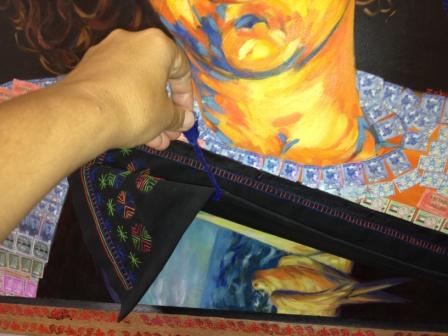
I want to show myself fitting into the world for whom I am, and for what I believe. The loss of my Father has frustrated me, and I am now grimly facing the meaning of life. I have painted the ancient Chinese shape of Yin Yang representing my love of mythology as a basis for thought. I am very interested in mythology. I admire the Phoenician tradition of how the universe began. A 1st Century Syrian philosopher named Fellow tried to summarise ancient Phoenician thought. He wrote that in the beginning there were the wind and darkness. The wind had fallen in love with darkness and introduced a feeling called desire. The resulting god, Mout, was molded from mud and became the seed for creating the world. This story is very similar to Mesopotamian mythology as desire was born from the deepest darkness. Desire connected the wind and the darkness, separating the positive and the negative, and resulting in the universe’s first egg. The sky and the earth were connected and their desire caused a separation between them. The Sumerian mother, Nomow, gave birth to this egg and of the myth continues on to describe how the permanent connection of desire between Earth and Sky made the world and all its life. My memento from my homeland with me here in the Emirates is my books “The Myth of Astarte” and the “Epic of Gilgamesh”. These books remind me of my childhood and the big discussions we would have as a family about our beliefs. I initially drew the outline of the goddess, Astarte, and the name of the book in Arabic.
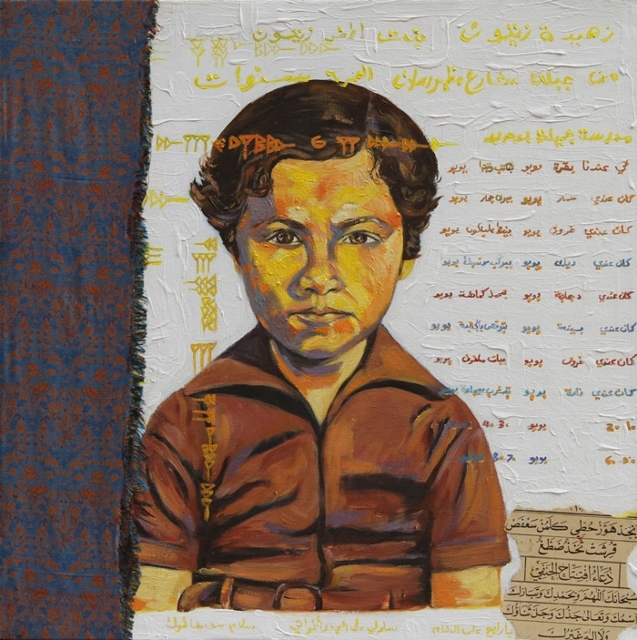
(acrylic, old nursery text, oil colour, brocade, 50x50cm) This self portrait represents me when I was six years old. I painted it from a registration photo at primary school. I used the photo to compose the painting in my favourite suit. Joseph Beuys in his Felt Suit project represents the transformation of humble felt cloth into a suit that symbolises power. Really, my suit gave me a feeling of confidence whenever I wore it. I agree with Beuys that the suit is not just a garment, but an idea. In the background are some Arabic words, like my name and my parents’ names, my primary school and my age at that time. I have written the same in Ugaritic script, but part of it is covered by the Syrian brocade. In the bottom right corner I have attached a piece of text taken from my old kindergarten book which is about learning Arabic letters. The text in the middle right is a lovely kids’ song. Kids in Syria have been singing for generations and this song in translation would touch everyone. Why? Well, when all of us were kids we played similar games and heard similar songs. The only differences I suppose were of names, countries, parentage and language. I grew up surrounded by ancient ruins and brought up on a big history, which is why I added the Ugaritic words and the brocade. My town of Jeblah is close to the archeological site of Ugarit where a tablet of one of the first alphabets was found. On a pillar at the site is depicted a woman, Bertha, who according to ancient legend was the first to embroider an abaya in order to win the hearts of others. The abaya has a V shape down the front of the wide dress with embroidered circles. The depiction dates to 2000 BC and yet the ancient seamstress’ design is still customary in Syria.
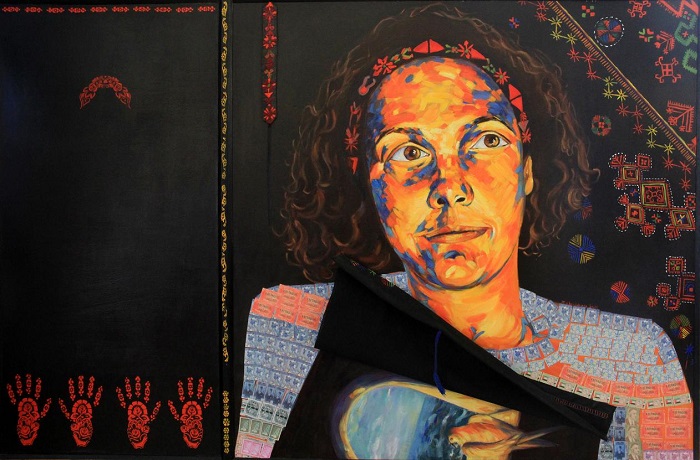
(acrylic and oil colour, embroidered cotton necktie, 167 x 114 x 5 cm) In this painting, I attempt to depict myself at the age of twenty—living with my family, dreaming of becoming an artist, and quietly grappling with the uncertainty of what lay ahead. At the time, I was studying economics, a path that pleased my father, while my true passion lay elsewhere. Whenever I could, I would escape from my academic obligations to attend classes at the Art Institute in Lattakia, holding fast to a dream that seemed both urgent and elusive. The painting I am shown holding within the portrait is, in fact, the second oil painting I ever created, some twenty years ago. It captures the longing I carried then—to leave Syria and my family in search of a place where I could live freely as an artist, and be wholly myself. That early painting is partly veiled by a piece of embroidered fabric. In many cultures, we refrain from sharing our dreams openly, unless with those closest to us. This gesture is mirrored here: the cloth invites the viewer to look more deeply, to gently imagine lifting the veil and discovering the vision hidden beneath. The embroidery symbolises the delicacy and concealment of that youthful aspiration. The face in the portrait is painted in oil, while the surrounding elements are rendered in acrylic—a deliberate contrast that draws attention to the emotional centre of the work. The garments worn by the figure are transformed into a mosaic through the careful placement of postage stamps. These stamps span various political periods in Syria’s history, reflecting the layered and complex identity I carry. Among them are stamps bearing the image of Queen Zenobia, a symbol of strength and resistance, subtly woven into the fabric of the dress—she becomes both a historical echo and a personal talisman. To the left of the composition is a panel where I used a henna glove, purchased locally, as a stencil to imprint hand motifs in henna pigment. This element pays homage to the Emirati tradition of women adorning their hands with intricate henna patterns, applied by skilled artists in salons. The handprint motif serves as a bridge between my Syrian past and my current life in the Emirates—a tender affirmation of belonging and transformation through place and time.
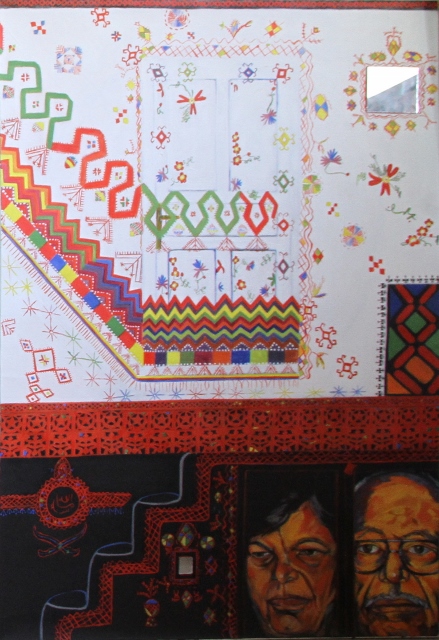
(acrylic, two small mirrors, oil colour, 107x 57 x 4 cm) The door, the cupboard with two faces of my parents, the embroidered frames around mirrors, the steps, the Quranic writing on the wall at the dark bottom of the painting, all represent my family. The different patterns on the door and around it, even under it, tell the story of my upbringing in a Syrian home. The colours and the number of patterns on the door refer to my sisters and brothers and how we communicated. However, when I was a child the painted door here lead to a different world as it was the entrance from the house to my father’s business where you could see a different sort of people. Omar Al Khayyam wrote a poem about a door: There was a door to which I found no key There was a veil past which I could not see Some little talk awhile of me and thee There seemed-and then no more of thee and me. I decided to paint the larger upper part in white, with happy patterns to talk about the joy and fun I had with my big family in Syria. I painted the darker, embroidered part with the serious looks of my parents on the two locked cupboard doors in contrast. I am depicting here the unhappy marriage my parents had in their time. They just lived for their children to give them a well supported life. I painted my parents at the bottom of the painting on the closed cupboard as they are not social people, and not very cheerful. All they wanted in their life was to raise their kids and be surrounded by them. My father died two years ago

(acrylic, oil colour, 50 x 50) The Self is a portrait of an important influencing person in my life: Nawal Al Saadawi. I called the painting The Self, as in a bigger self, not a small identity forced on me by society, culture, religion or the media. Saadawi goes beyond the limits of what defines her as a woman and encourages others to share her commitment to create a fairer and more equal society. Saadawi continues the struggle for ‘liberation’, ‘love’ and ‘equality’ and that is why I included these values in English and Arabic on Saadawi’s shoulder.

(acrylic and oil colour, 163 x 113 cm) Through this painting I am trying to balance my three worlds: Syria, the Emirates and Australia. The Syrian style clock with broken hands symbolises my time in Syria. The symbols to the right refer to Syrian mythology. Astarte’s symbols were many: fish, snakes, the moon, a pigeon, the tree with the moon on top, a pot, fire and even a cross. And here I thought to place olive leaves in my hand to talk about my ‘olive’ roots in Syria while holding the palm tree leaf in the other hand, representing the Emirati land I am living in. I also hold the gum tree leaf representing my family in Australia. Meanwhile, on the left side of the painting I depict sailing boats, surfers, the Opera House, Sydney Harbour; icons that symbolise Australia. The high rise building and sailing boats symbolise the Emirates as does the palm fond next to the gum leaves. In my eyes both the Emirates and Australia are very different to Syria: in the Emirates I am surrounded with English language speakers, unlike in Syria. I rarely speak Arabic in the UAE……or even have communication with Arabs!!!!!! Then of course there are the religious symbols. I do not believe that any of the religions are in opposition. They are all about love. Some of the images are of ancient faiths such as Astarte. Zahidah 4 is also a study for what Zahidah is thinking about, surrounded with opposing extremes and trying to balance all these to live with or get around. The work is my own form of meditation. I have drawn a typical Syrian embroidered design and emphasized the colour so as to show my admiration for the beauty of handmade material, like stitching, and to tell my story through the embroidery. I used jasmine in the dress, a typical flower in Syrian homes. For centuries embroidered patterns have been based on symbols of hope, wealth, good health and protection. They have had traditional names that reflect natural features such as the moon and specific trees, the cypress especially, and representations of the tree of life. The craftswoman could express her individual creativity by her choice of pattern and arrangement on the dress. She would also present imaginative views of the world through stitch work, very often a social commentary on the world.

(acrylic and oil, 170 x 124 cm) I have explained my feelings here through the eyes: one eye is a call for demonstration, and the other is a scream. My choice of colour and the poem also emphasise my feelings. The Omar Al Khayam poem in Arabic painted on the silver pot is about someone wondering that if he were a god, he would give people the chance to be free. The other script on the bottom panel is from a popular Arabic song talking about breaking fear and silence. The poem has recently become popular since the beginning of Syrian unrest. The fear the poem refers to has been with Syrian people for the last 40 years. The surrounding flowery decoration is in a 17th/18th century Iranian style.
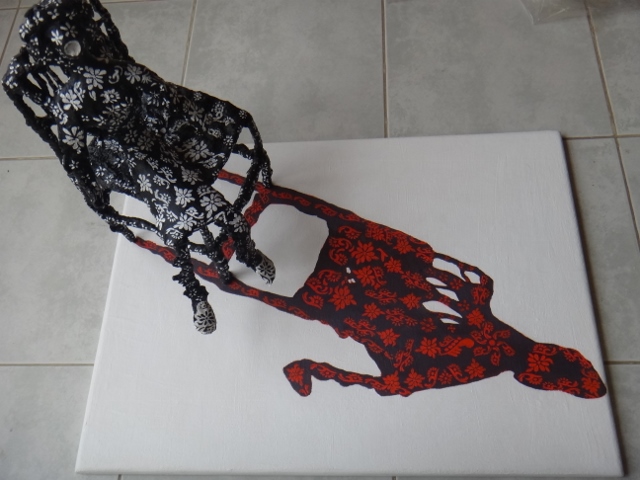
(acrylic colour, wire, wood, plaster and lightweight Spackling, 60 x 44 cm, height 40 cm). I used what I found around me in my studio and the house. I tried to show in this simple sculpture my feelings towards what is happening in my country, Syria. I am roped into the corner of a chair screaming because I can’t do anything. The image, the chair and the shadow are painted with jasmine flowers to symbolise the revolution, the Jasmine Revolution, or Arab Spring Revolution. In the shadow the flowers turn red to represent my view of this revolution as filled with blood and death. The legs of the chair become part of the body in the shadow. I am all tied up here in the Emirates and I can’t provide any help for my fellow Syrian people. I can’t even help my family who live in Lattakia (thank goodness everything is still quiet there up till now). My family can’t get a visa to the Emirates to visit me!! The Emirates has made it difficult for Syrians to carry out business here, even banning me from inviting my family to visit me here!!! I am in fear of losing my family, my family home and my family’s town!!!
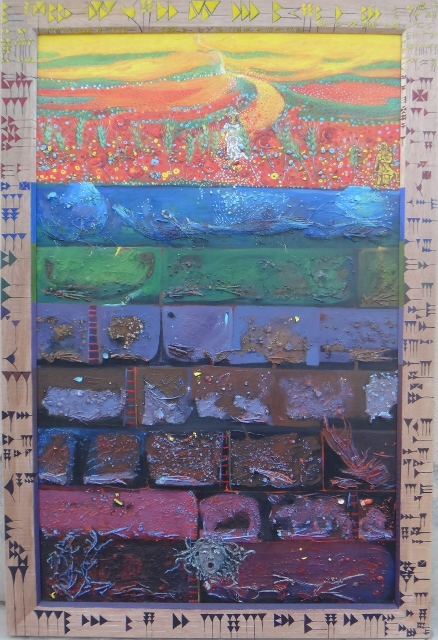
My turning 40 and the death of my father encouraged me to look inside myself, being like Gilgamesh in a time of searching as he roamed, walking between lands searching for the meaning of life. I am treating my latest project, ‘Zahidah’, as a narrative, an opportunity to communicate how I have transformed over time. I am asking the viewer to associate particular events to a broad conception of events. On the upper level I am trying to talk about the celebrity of life and death. The red flowers represent the anemone spring flowers. Flowers are the sign of the start of spring in Syria, to be followed with a healthy land full of wheat. Their presence in Spring in Syrian mythology is a sign of a well fertilized soil. At present the Syrian soil is soaking blood and receiving a lot of bodies. The flower is also a symbol of the blood of the dead. The deaths occurring at the moment just as Spring starts are in a way nourishing an already healthy land. According to Syrian mythology, the red anemone flower represents the rebirth of the god Tammuz who dies in Autumn and comes back to life in Spring. He is the son of the mother goddess, Ishtar (Flora, Isis). I represent Ishtar with her snake on the shoulder surrounded with flowers and wheat. On the upper right side I place Gilagmesh next to the eastern hole to the Underworld. He is searching for the meaning of life and death after the death of his friend Ankido, as according to the Epic of Gilgamesh. Dark colours represent the seven underworld levels. I added Medusa in the last level to represent the last level of death. Our Syrian death goddess is called Ereshkigal. I use calm and quiet colours for the underworld to show the beauty of death despite our fear we have of it. Medusa represents that fear. The more underground the level, the warmer the colours become. I painted the upper two levels with blue, then green. As the levels go down and the environment gets quieter, I use more relaxing, warm colours. According to mythology on the way to the underground there are two big holes. One is to the east, while the other is in the west. Those who are meant to die will go first through one of these holes, and face a river to get under. As the deceased moves to a new level, his or her powers reduce at each level passed through. I also consider the painting in a more personal way. I put Ishtar opposite Medusa to represent myself in moods of happiness and anger. The underworld could be also me trying to dig deep inside myself. I have also tried to represent my poetic thoughts of life and death through Syrian mythology, and my poetic thoughts of survival for what is happening in my land Syria. I experienced great emotional feeling when I was doing this painting. I didn’t want to finish! The writing around the frame is examples of ancient Ugaritic letters from tablets of the ancient language first found at Ras Al Shamra (Ugarit, dated around 3500 BC), near my family’s town. I transliterated some Arabic letters to Ugaritic using them in the painting. It is fascinating that Arabic possesses the sounds of Ugaritic! The Epic Of Gilgamesh was of course first written in an earlier cuneiform Sumerian language.

(acrylic, oil, text, 142 x90 cm) I miss my friend and neighbour. We used to enjoy a wonderful coffee morning after a game of tennis. We would discuss a whole range of topics, from politics to history, art to education. This painting is about what I now miss talking about with her since she left our town. Most of the images in this painting are in my sun room, a place where I usually sit in the morning to drink coffee. The books I depict are normally located on the coffee table in a similar way as you see them in the painting. The first book is about Rodin, the second is a book of old Arab paintings, while the third is of contemporary Arab artists. Even the pot plant is located in its normal spot on the table, as is the Syrian designed chess board. I thought to paint the coffee table while I was reading a piece on Albert Einstein and his theory about “space time”. I found out that the images in this room speak a lot about my daily contemplating before I start my day’s painting.

(450 x 300 cm, three canvases each of 150 x 100 cm, acrylic, oil, pieces of wood) In Wadi Sha’am near the northern Emirates border to Oman there is an abandoned village called Al Awala. Nobody lives there, only goats! The inhabitants decided to leave their old houses to move to a new house provided by the government with electricity. In the cool months of the year, November to May, I go there once a week to paint the mountains. The wadi is surrounded with mountains and old, abandoned houses. I feel a great energy there, a real happiness with the life around me. I loved painting there, away from the complicated world and its news, especially about my country Syria. We belong to the land, the air and water. We come from it and dissolve it in.
Symphony of the Myth of Life & Death.
My turning 40 and the death of my father encouraged me to look inside myself, being like Gilgamesh in a time of searching as he roamed, walking between lands searching for the meaning of life. I am treating my latest project, ‘Zahidah’, as a narrative, an opportunity to communicate how I have transformed over time. I am asking the viewer to associate particular events to a broad conception of events.
On the upper level I am trying to talk about the celebrity of life and death. The red flowers represent the anemone spring flowers. Flowers are the sign of the start of spring in Syria, to be followed with a healthy land full of wheat. Their presence in Spring in Syrian mythology is a sign of a well fertilized soil. At present the Syrian soil is soaking blood and receiving a lot of bodies. The flower is also a symbol of the blood of the dead. The deaths occurring at the moment just as Spring starts are in a way nourishing an already healthy land. According to Syrian mythology, the red anemone flower represents the rebirth of the god Tammuz who dies in Autumn and comes back to life in Spring. He is the son of the mother goddess, Ishtar (Flora, Isis). I represent Ishtar with her snake on the shoulder surrounded with flowers and wheat. On the upper right side I place Gilagmesh next to the eastern hole to the Underworld. He is searching for the meaning of life and death after the death of his friend Ankido, as according to the Epic of Gilgamesh. Dark colours represent the seven underworld levels. I added Medusa in the last level to represent the last level of death. Our Syrian death goddess is called Ereshkigal. I use calm and quiet colours for the underworld to show the beauty of death despite our fear we have of it. Medusa represents that fear. The more underground the level, the warmer the colours become. I painted the upper two levels with blue, then green. As the levels go down and the environment gets quieter, I use more relaxing, warm colours.
According to mythology on the way to the underground there are two big holes. One is to the east, while the other is in the west. Those who are meant to die will go first through one of these holes, and face a river to get under. As the deceased moves to a new level, his or her powers reduce at each level passed through.
I also consider the painting in a more personal way. I put Ishtar opposite Medusa to represent myself in moods of happiness and anger. The underworld could be also me trying to dig deep inside myself. I have also tried to represent my poetic thoughts of life and death through Syrian mythology, and my poetic thoughts of survival for what is happening in my land Syria. I experienced great emotional feeling when I was doing this painting. I didn’t want to finish!
The writing around the frame is examples of ancient Ugaritic letters from tablets of the ancient language first found at Ras Al Shamra (Ugarit, dated around 3500 BC), near my family’s town. I transliterated some Arabic letters to Ugaritic using them in the painting. It is fascinating that Arabic possesses the sounds of Ugaritic! The Epic Of Gilgamesh was of course first written in an earlier cuneiform Sumerian language.
“Said the tavern-keeper to him, to Gilgamesh:
‘O Gilgamesh, where are you wondering?
‘The life that you seek you never will find:
When the gods created mankind,
Death they dispensed to mankind,
Life they kept for themselves,
‘But you, Gilgamesh, let your belly be full,
Enjoy yourself always by day and by night!
Make merry each day,
dance and play day and night!
‘Let your clothes be clean,
Let your head be washed, may you bathe in water!
Gaze on the child who holds your hand,
Let your wife enjoy your repeated embrace!
‘For such is the destiny (of mortal men,)
That the one who lives……………’
Zahidah 1
I want to show myself fitting into the world for whom I am, and for what I believe. The loss of my Father has frustrated me, and I am now grimly facing the meaning of life. I have painted the ancient Chinese shape of Yin Yang representing my love of mythology as a basis for thought. I am very interested in mythology. I admire the Phoenician tradition of how the universe began.
A 1st Century Syrian philosopher named Fellow tried to summarise ancient Phoenician thought. He wrote that in the beginning there were the wind and darkness. The wind had fallen in love with darkness and introduced a feeling called desire. The resulting god, Mout, was molded from mud and became the seed for creating the world. This story is very similar to Mesopotamian mythology as desire was born from the deepest darkness.

Desire connected the wind and the darkness, separating the positive and the negative, and resulting in the universe’s first egg. The sky and the earth were connected and their desire caused a separation between them. The Sumerian mother, Nomow, gave birth to this egg and of the myth continues on to describe how the permanent connection of desire between Earth and Sky made the world and all its life.
My memento from my homeland with me here in the Emirates is my books “The Myth of Astarte” and the “Epic of Gilgamesh”. These books remind me of my childhood and the big discussions we would have as a family about our beliefs. I initially drew the outline of the goddess, Astarte, and the name of the book in Arabic.
Zahidah 2
(acrylic, old nursery text, oil colour, brocade, 50x50cm)
This self portrait represents me when I was six years old. I painted it from a registration photo at primary school. I used the photo to compose the painting in my favourite suit. Joseph Beuys in his Felt Suit project represents the transformation of humble felt cloth into a suit that symbolises power. Really, my suit gave me a feeling of confidence whenever I wore it. I agree with Beuys that the suit is not just a garment, but an idea.
In the background are some Arabic words, like my name and my parents’ names, my primary school and my age at that time. I have written the same in Ugaritic script, but part of it is covered by the Syrian brocade. In the bottom right corner I have attached a piece of text taken from my old kindergarten book which is about learning Arabic letters. The text in the middle right is a lovely kids’ song. Kids in Syria have been singing for generations and this song in translation would touch everyone. Why? Well, when all of us were kids we played similar games and heard similar songs. The only differences I suppose were of names, countries, parentage and language.
I grew up surrounded by ancient ruins and brought up on a big history, which is why I added the Ugaritic words and the brocade. My town of Jeblah is close to the archeological site of Ugarit where a tablet of one of the first alphabets was found. On a pillar at the site is depicted a woman, Bertha, who according to ancient legend was the first to embroider an abaya in order to win the hearts of others. The abaya has a V shape down the front of the wide dress with embroidered circles. The depiction dates to 2000 BC and yet the ancient seamstress’ design is still customary in Syria.

Zahidah 2
(acrylic and oil colour, embroidered cotton necktie, 167 x 114 x 5 cm)
In this painting, I attempt to depict myself at the age of twenty—living with my family, dreaming of becoming an artist, and quietly grappling with the uncertainty of what lay ahead. At the time, I was studying economics, a path that pleased my father, while my true passion lay elsewhere. Whenever I could, I would escape from my academic obligations to attend classes at the Art Institute in Lattakia, holding fast to a dream that seemed both urgent and elusive.
The painting I am shown holding within the portrait is, in fact, the second oil painting I ever created, some twenty years ago. It captures the longing I carried then—to leave Syria and my family in search of a place where I could live freely as an artist, and be wholly myself.

That early painting is partly veiled by a piece of embroidered fabric. In many cultures, we refrain from sharing our dreams openly, unless with those closest to us. This gesture is mirrored here: the cloth invites the viewer to look more deeply, to gently imagine lifting the veil and discovering the vision hidden beneath. The embroidery symbolises the delicacy and concealment of that youthful aspiration.
The face in the portrait is painted in oil, while the surrounding elements are rendered in acrylic—a deliberate contrast that draws attention to the emotional centre of the work. The garments worn by the figure are transformed into a mosaic through the careful placement of postage stamps. These stamps span various political periods in Syria’s history, reflecting the layered and complex identity I carry. Among them are stamps bearing the image of Queen Zenobia, a symbol of strength and resistance, subtly woven into the fabric of the dress—she becomes both a historical echo and a personal talisman.
To the left of the composition is a panel where I used a henna glove, purchased locally, as a stencil to imprint hand motifs in henna pigment. This element pays homage to the Emirati tradition of women adorning their hands with intricate henna patterns, applied by skilled artists in salons. The handprint motif serves as a bridge between my Syrian past and my current life in the Emirates—a tender affirmation of belonging and transformation through place and time.
Zahidah 3
(acrylic, two small mirrors, oil colour, 107x 57 x 4 cm)
The door, the cupboard with two faces of my parents, the embroidered frames around mirrors, the steps, the Quranic writing on the wall at the dark bottom of the painting, all represent my family. The different patterns on the door and around it, even under it, tell the story of my upbringing in a Syrian home. The colours and the number of patterns on the door refer to my sisters and brothers and how we communicated.
However, when I was a child the painted door here lead to a different world as it was the entrance from the house to my father’s business where you could see a different sort of people.
Omar Al Khayyam wrote a poem about a door:
There was a door to which I found no key
There was a veil past which I could not see
Some little talk awhile of me and thee
There seemed-and then no more of thee and me.
I decided to paint the larger upper part in white, with happy patterns to talk about the joy and fun I had with my big family in Syria. I painted the darker, embroidered part with the serious looks of my parents on the two locked cupboard doors in contrast. I am depicting here the unhappy marriage my parents had in their time. They just lived for their children to give them a well supported life. I painted my parents at the bottom of the painting on the closed cupboard as they are not social people, and not very cheerful. All they wanted in their life was to raise their kids and be surrounded by them. My father died two years ago

The Self

(acrylic, oil colour, 50 x 50)
The Self is a portrait of an important influencing person in my life: Nawal Al Saadawi. I called the painting The Self, as in a bigger self, not a small identity forced on me by society, culture, religion or the media. Saadawi goes beyond the limits of what defines her as a woman and encourages others to share her commitment to create a fairer and more equal society. Saadawi continues the struggle for ‘liberation’, ‘love’ and ‘equality’ and that is why I included these values in English and Arabic on Saadawi’s shoulder.
Zahidah 4
(acrylic and oil colour, 163 x 113 cm)
Through this painting I am trying to balance my three worlds: Syria, the Emirates and Australia. The Syrian style clock with broken hands symbolises my time in Syria. The symbols to the right refer to Syrian mythology. Astarte’s symbols were many: fish, snakes, the moon, a pigeon, the tree with the moon on top, a pot, fire and even a cross.
And here I thought to place olive leaves in my hand to talk about my ‘olive’ roots in Syria while holding the palm tree leaf in the other hand, representing the Emirati land I am living in. I also hold the gum tree leaf representing my family in Australia. Meanwhile, on the left side of the painting I depict sailing boats, surfers, the Opera House, Sydney Harbour; icons that symbolise Australia. The high rise building and sailing boats symbolise the Emirates as does the palm fond next to the gum leaves. In my eyes both the Emirates and Australia are very different to Syria: in the Emirates I am surrounded with English language speakers, unlike in Syria. I rarely speak Arabic in the UAE……or even have communication with Arabs!!!!!!

Then of course there are the religious symbols. I do not believe that any of the religions are in opposition. They are all about love. Some of the images are of ancient faiths such as Astarte. Zahidah 4 is also a study for what Zahidah is thinking about, surrounded with opposing extremes and trying to balance all these to live with or get around. The work is my own form of meditation.
I have drawn a typical Syrian embroidered design and emphasized the colour so as to show my admiration for the beauty of handmade material, like stitching, and to tell my story through the embroidery.
I used jasmine in the dress, a typical flower in Syrian homes. For centuries embroidered patterns have been based on symbols of hope, wealth, good health and protection. They have had traditional names that reflect natural features such as the moon and specific trees, the cypress especially, and representations of the tree of life.
The craftswoman could express her individual creativity by her choice of pattern and arrangement on the dress. She would also present imaginative views of the world through stitch work, very often a social commentary on the world.
Zahidah 5

(acrylic and oil, 170 x 124 cm)
I have explained my feelings here through the eyes: one eye is a call for demonstration, and the other is a scream. My choice of colour and the poem also emphasise my feelings.
The Omar Al Khayam poem in Arabic painted on the silver pot is about someone wondering that if he were a god, he would give people the chance to be free. The other script on the bottom panel is from a popular Arabic song talking about breaking fear and silence. The poem has recently become popular since the beginning of Syrian unrest. The fear the poem refers to has been with Syrian people for the last 40 years. The surrounding flowery decoration is in a 17th/18th century Iranian style.
The White Jasmine has Turned Red
(acrylic colour, wire, wood, plaster and lightweight Spackling, 60 x 44 cm, height 40 cm).
I used what I found around me in my studio and the house. I tried to show in this simple sculpture my feelings towards what is happening in my country, Syria. I am roped into the corner of a chair screaming because I can’t do anything.
The image, the chair and the shadow are painted with jasmine flowers to symbolise the revolution, the Jasmine Revolution, or Arab Spring Revolution. In the shadow the flowers turn red to represent my view of this revolution as filled with blood and death. The legs of the chair become part of the body in the shadow.
I am all tied up here in the Emirates and I can’t provide any help for my fellow Syrian people. I can’t even help my family who live in Lattakia (thank goodness everything is still quiet there up till now). My family can’t get a visa to the Emirates to visit me!! The Emirates has made it difficult for Syrians to carry out business here, even banning me from inviting my family to visit me here!!! I am in fear of losing my family, my family home and my family’s town!!!
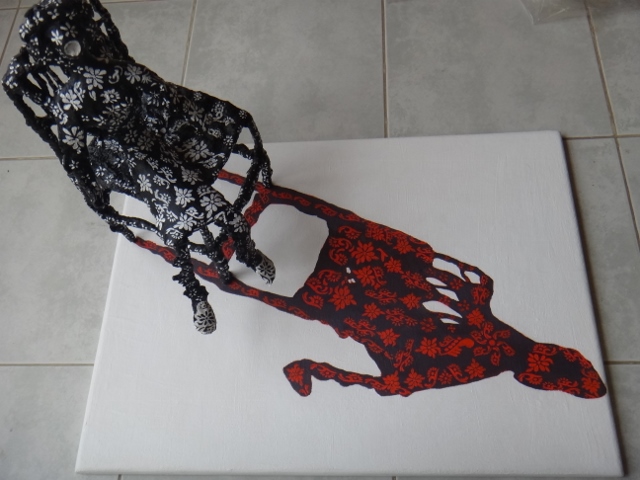
Zahidah 6
(450 x 300 cm, three canvases each of 150 x 100 cm, acrylic, oil, pieces of wood)

In Wadi Sha’am near the northern Emirates border to Oman there is an abandoned village called Al Awala. Nobody lives there, only goats! The inhabitants decided to leave their old houses to move to a new house provided by the government with electricity. In the cool months of the year, November to May, I go there once a week to paint the mountains. The wadi is surrounded with mountains and old, abandoned houses. I feel a great energy there, a real happiness with the life around me. I loved painting there, away from the complicated world and its news, especially about my country Syria. We belong to the land, the air and water. We come from it and dissolve it in.
Coffee Morning in The Sunroom
(acrylic, oil, text, 142 x90 cm)
I miss my friend and neighbour. We used to enjoy a wonderful coffee morning after a game of tennis. We would discuss a whole range of topics, from politics to history, art to education. This painting is about what I now miss talking about with her since she left our town.

Most of the images in this painting are in my sun room, a place where I usually sit in the morning to drink coffee. The books I depict are normally located on the coffee table in a similar way as you see them in the painting. The first book is about Rodin, the second is a book of old Arab paintings, while the third is of contemporary Arab artists. Even the pot plant is located in its normal spot on the table, as is the Syrian designed chess board.
I thought to paint the coffee table while I was reading a piece on Albert Einstein and his theory about “space time”. I found out that the images in this room speak a lot about my daily contemplating before I start my day’s painting.
